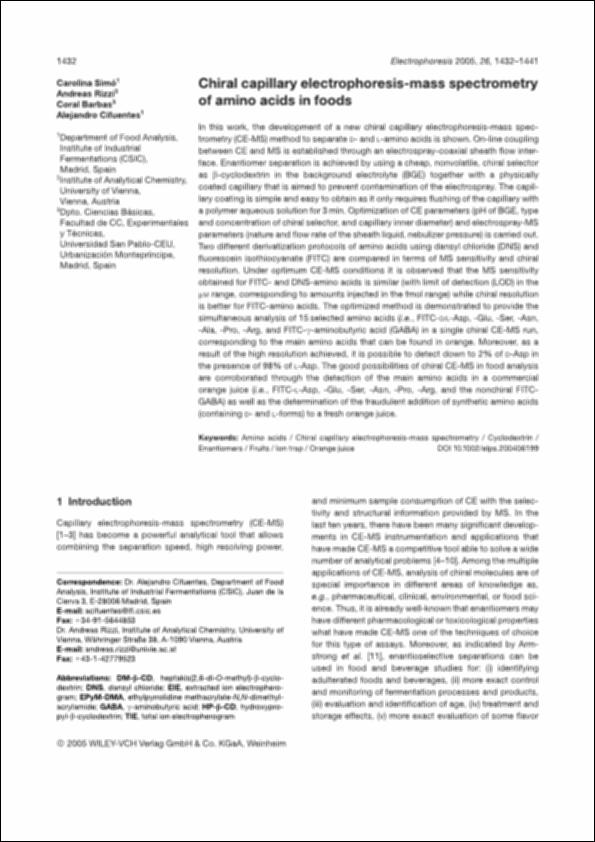Por favor, use este identificador para citar o enlazar este ítem:
http://hdl.handle.net/10637/829Chiral capillary electrophoresis-mass spectrometry of amino acids in foods.
| Título : | Chiral capillary electrophoresis-mass spectrometry of amino acids in foods. |
| Autor : | Simó, Carolina Cifuentes, Alejandro |
| Materias: | Amino acids.; Chiral capillary electrophoresis-mass spectrometry.; Cyclodextrin.; Enantiomers.; Fruits.; Ion trap.; Orange juice.; Rizzi, Andreas.; Barbas Arribas, Coral. |
| Resumen : | In this work, the development of a new chiral capillary electrophoresis-mass spectrometry (CE-MS) method to separate D- and L-amino acids is shown. On-line coupling between CE and MS is established through an electrospray-coaxial sheath flow interface. Enantiomer separation is achieved by using a cheap, nonvolatile, chiral selector as b-cyclodextrin in the background electrolyte (BGE) together with a physically coated capillary that is aimed to prevent contamination of the electrospray. The capillary coating is simple and easy to obtain as it only requires flushing of the capillary with a polymer aqueous solution for 3 min. Optimization of CE parameters (pH of BGE, type and concentration of chiral selector, and capillary inner diameter) and electrospray-MS parameters (nature and flow rate of the sheath liquid, nebulizer pressure) is carried out. Two different derivatization protocols of amino acids using dansyl chloride (DNS) and fluorescein isothiocyanate (FITC) are compared in terms of MS sensitivity and chiral resolution. Under optimum CE-MS conditions it is observed that the MS sensitivity obtained for FITC- and DNS-amino acids is similar (with limit of detection (LOD) in the mM range, corresponding to amounts injected in the fmol range) while chiral resolution is better for FITC-amino acids. The optimized method is demonstrated to provide the simultaneous analysis of 15 selected amino acids (i.e., FITC-D/L-Asp, -Glu, -Ser, -Asn, -Ala, -Pro, -Arg, and FITC-g-aminobutyric acid (GABA) in a single chiral CE-MS run, corresponding to the main amino acids that can be found in orange. Moreover, as a result of the high resolution achieved, it is possible to detect down to 2% of D-Asp in the presence of 98% of L-Asp. The good possibilities of chiral CE-MS in food analysis are corroborated through the detection of the main amino acids in a commercial orange juice (i.e., FITC-L-Asp, -Glu, -Ser, -Asn, -Pro, -Arg, and the nonchiral FITCGABA) as well as the determination of the fraudulent addition of synthetic amino acids (containing D- and L-forms) to a fresh orange juice |
| Descripción : | En: Electrophoresis, ISSS 1522-2683, 2005, 26 : 1432-1441 p.. 1522-2683 |
| URI : | http://hdl.handle.net/10637/829 |
| Derechos: | http://creativecommons.org/licenses/by-nc-nd/4.0/deed.es |
| Fecha de publicación : | 19-sep-2005 |
| Centro : | Universidad San Pablo-CEU |
| Aparece en las colecciones: | Facultad de Farmacia |
Los ítems de DSpace están protegidos por copyright, con todos los derechos reservados, a menos que se indique lo contrario.


